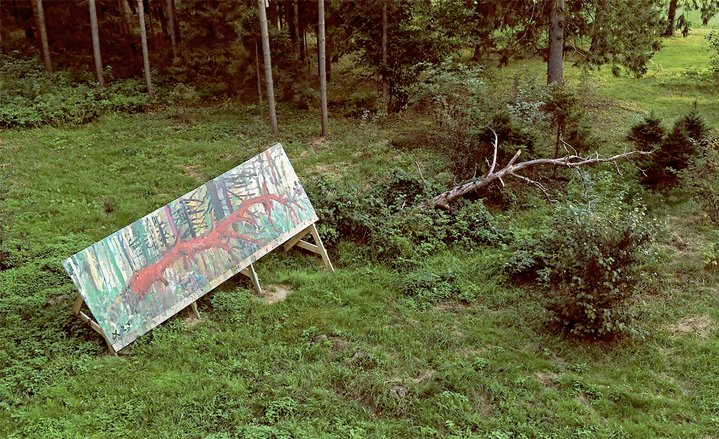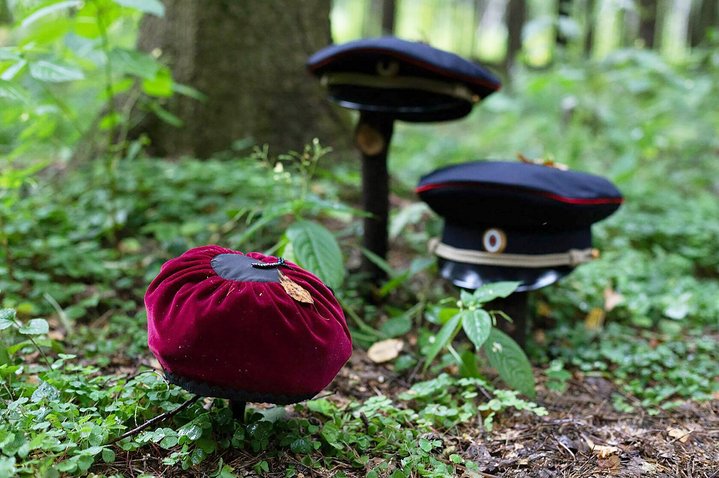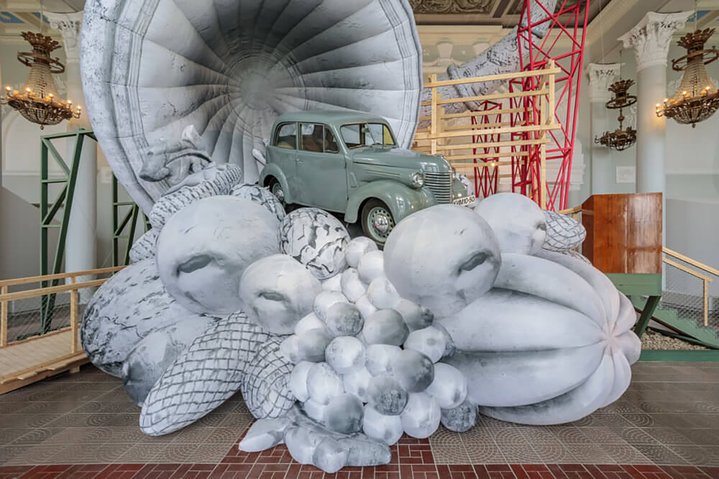Artistic Solitude. A herd of wild barbecues, 2020. CHA SCHA. Exhibition in the Woods. Courtesy of Jart gallery
The tipping point between ‘I’ and ‘We’
Russian artists are leading the international trend to band together. I ask one group, Artistic Solitude, why?
There appears to be irony in the name of the Russian collective, Artistic Solitude. The Bohemian vision of an artist as a loner in his garret has long misled people about the diverse ways contemporary artists live and work. In this outdated vision artists need solitude to create art. Some still do, a certain amount of isolation gives most of us time to think. I suggested to Irina Korina (b. 1977) a member of Artistic Solitude that the reason why artists might be working together closer today was changing ideas about identity, but she denied that, maintaining that the reason that the six of them came together three years ago to make a work in the thicket of a forest, Cha Shcha, was more basic. She wanted to overcome the complications of making a work of art outside. The installation was in a relatively inaccessible wood. She wanted to break that solitude. It can be lonely in a wood.
With the fighting in the Ukraine people in Russia feel more isolated than ever, but there is nothing new about the sense of solitude in this part of the world. This is demonstrated in a strange way by a historical exhibition that Korina worked on this year in her own right (outside the group) for the Transport Museum. The Horn of Plenty: Moskvich’s Dream, highlights how modern life can lock people in their own minds, how public fantasies can leave one with nothing but empty air. For the exhibition, Korina made a sculpture out of fruits and other organic materials. The exhibition tells the story of a car that never existed. It was commissioned by Stalin, but never went beyond the glamourous PR shots made with the prototype. It certainly has not competed with the longest run production of the 21 million models of Hitler’s Volkswagen Beetle. When Stalin saw the prototype he was angry as it only had two doors (like the Beetle of course) but Stalin wanted four doors so he sent it back to the drawing board and that was the last that was heard of it.
The pictures of the glamour girls spread across the bonnet of the Moskvich remind me of the Polish artist, Paulina Olowska’s (b. 1976) series of work about knitwear patterns, taken from Soviet magazines of the 50s and 60s. Olowska conjures up the competition between the domestic dreams of Communism and Capitalism. It is the same with the Moskvich: a Russian girl draped over a Russian car’s bonnet is much like an American model promoting an American car.
There are five other members of Artistic Solitude, Oleg Eliseev (b. 1985), Evgeny Kukoverov (b. 1984), Alexei Kononenko (b. 1968), Olga Petrunenko (b. 1972), and Ilya Voznesensky (b. 1970). The group consists of three artists and three architects. Eliseev and Kukoverov have been working together since 2007 as an artist tandem called Elikuka, while Voznesensky and Kononenko are members of the Iced Architects collective founded in 1993. Several of the group are also musicians. In talking about the work in the forest the group refer to earlier Land Artists. I personally see more connections with the Collective Action Group. Korina admits that Andrei Monastirsky (b. 1949) is her favourite artist. Boris Groys once said that Moscow Conceptualism was about the balance between text and image. I suggest to Artistic Solitude that they are finding the tipping balance between the ‘I’ and the ‘We’. Korina says the balance is important, that ‘Working in a group might bring with it more communication problems, but it also brings a warm sense of working with a family.’ The social side should not be underestimated. They have fun working together. Recently they came together with some ten or so other artists to raise money for Ukrainian and Russian refugees and in one night made 5000 euros.
As Korina is allowed a favourite artist, I counter that the Collective in the world I most admire is the Raqs Media Collective which consists of three ex-film students from Delhi who have been working together for well over twenty years. I maintain to Artistic Solitude that Raqs’ success comes from the development of John Donne’s famous 1624 treatise that ‘No man is an island entire of itself.’ I explain that in talking to Raqs it is often feels that they have expanded their brain and feelings into an ever-curious unit that is more than Descartes’ ego. In communicating with others it is as if they are including you as an extra cog or two in their brain. Raqs like Artistic Solitude is neither male or female as it includes both

Artistic Solitude. Tree portraits, 2020. CHA SCHA. Exhibition in the Woods. Courtesy of Jart gallery
The very name Artistic Solitude rings the death knell to the idea of the lonely male artist in his ivory tower. Since the Constructivists and other groupings of artists played a crucial role in the fermenting of the Russian Revolution, Russian artists have led the way in exploring new ways of engaging with their audience, however limited circumstances have made. Learning from the way the authorities tried to suffocate their art, later generations have created art forms that have escaped the Cartesian Ego. The many different groupings of Moscow Conceptualism explored the friction between the stark brutality of a protest banner and the environment in which those words are fluttering in the wind. Artistic Solitude seem to be following in their steps, trying to find the tipping point between ‘I’ and ‘We’.









